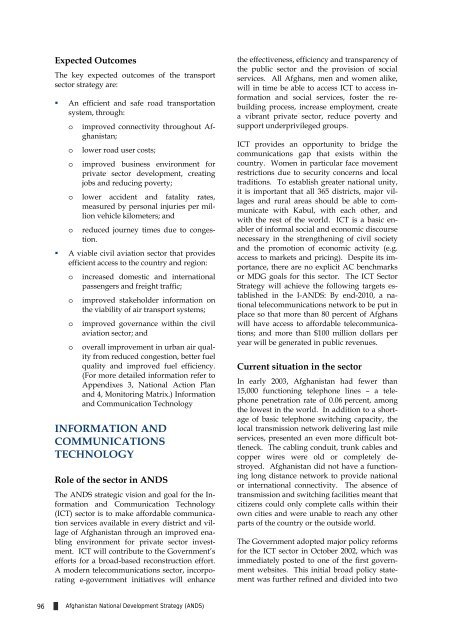Islamic Republic of Afghanistan - Enhanced Integrated Framework ...
Islamic Republic of Afghanistan - Enhanced Integrated Framework ...
Islamic Republic of Afghanistan - Enhanced Integrated Framework ...
Create successful ePaper yourself
Turn your PDF publications into a flip-book with our unique Google optimized e-Paper software.
Expected OutcomesThe key expected outcomes <strong>of</strong> the transportsector strategy are:• An efficient and safe road transportationsystem, through:oooimproved connectivity throughout <strong>Afghanistan</strong>;lower road user costs;improved business environment forprivate sector development, creatingjobs and reducing poverty;o lower accident and fatality rates,measured by personal injuries per millionvehicle kilometers; andoreduced journey times due to congestion.• A viable civil aviation sector that providesefficient access to the country and region:ooooincreased domestic and internationalpassengers and freight traffic;improved stakeholder information onthe viability <strong>of</strong> air transport systems;improved governance within the civilaviation sector; andoverall improvement in urban air qualityfrom reduced congestion, better fuelquality and improved fuel efficiency.(For more detailed information refer toAppendixes 3, National Action Planand 4, Monitoring Matrix.) Informationand Communication TechnologyINFORMATION ANDCOMMUNICATIONSTECHNOLOGYRole <strong>of</strong> the sector in ANDSThe ANDS strategic vision and goal for the Informationand Communication Technology(ICT) sector is to make affordable communicationservices available in every district and village<strong>of</strong> <strong>Afghanistan</strong> through an improved enablingenvironment for private sector investment.ICT will contribute to the Government’sefforts for a broad-based reconstruction effort.A modern telecommunications sector, incorporatinge-government initiatives will enhancethe effectiveness, efficiency and transparency <strong>of</strong>the public sector and the provision <strong>of</strong> socialservices. All Afghans, men and women alike,will in time be able to access ICT to access informationand social services, foster the rebuildingprocess, increase employment, createa vibrant private sector, reduce poverty andsupport underprivileged groups.ICT provides an opportunity to bridge thecommunications gap that exists within thecountry. Women in particular face movementrestrictions due to security concerns and localtraditions. To establish greater national unity,it is important that all 365 districts, major villagesand rural areas should be able to communicatewith Kabul, with each other, andwith the rest <strong>of</strong> the world. ICT is a basic enabler<strong>of</strong> informal social and economic discoursenecessary in the strengthening <strong>of</strong> civil societyand the promotion <strong>of</strong> economic activity (e.g.access to markets and pricing). Despite its importance,there are no explicit AC benchmarksor MDG goals for this sector. The ICT SectorStrategy will achieve the following targets establishedin the I-ANDS: By end-2010, a nationaltelecommunications network to be put inplace so that more than 80 percent <strong>of</strong> Afghanswill have access to affordable telecommunications;and more than $100 million dollars peryear will be generated in public revenues.Current situation in the sectorIn early 2003, <strong>Afghanistan</strong> had fewer than15,000 functioning telephone lines – a telephonepenetration rate <strong>of</strong> 0.06 percent, amongthe lowest in the world. In addition to a shortage<strong>of</strong> basic telephone switching capacity, thelocal transmission network delivering last mileservices, presented an even more difficult bottleneck.The cabling conduit, trunk cables andcopper wires were old or completely destroyed.<strong>Afghanistan</strong> did not have a functioninglong distance network to provide nationalor international connectivity. The absence <strong>of</strong>transmission and switching facilities meant thatcitizens could only complete calls within theirown cities and were unable to reach any otherparts <strong>of</strong> the country or the outside world.The Government adopted major policy reformsfor the ICT sector in October 2002, which wasimmediately posted to one <strong>of</strong> the first governmentwebsites. This initial broad policy statementwas further refined and divided into two96<strong>Afghanistan</strong> National Development Strategy (ANDS)
















